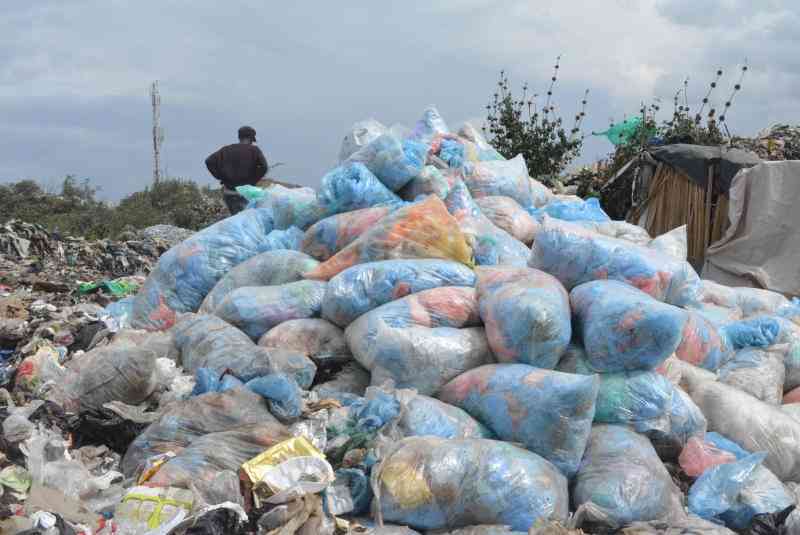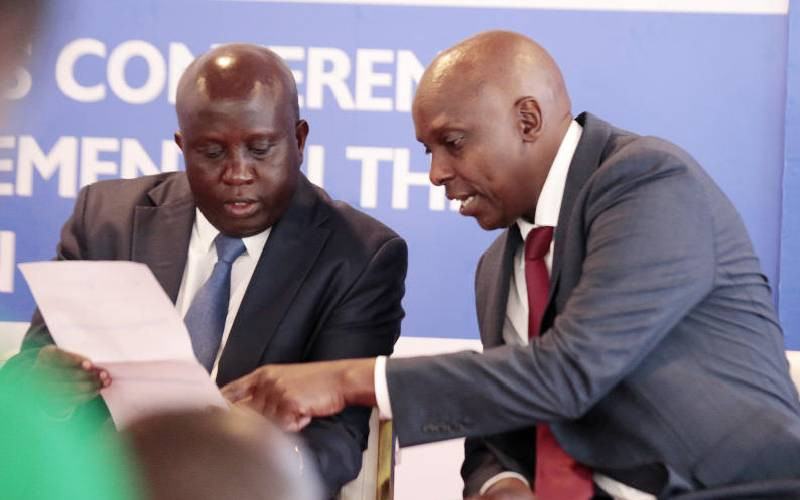By PETER ORENGO
Mombasa, Kenya: Taking an early morning walk along the scenic stretch of Mombasa’s Jomo Kenyatta Public Beach can be quite a refreshing way to start the day.
But not when you encounter remnants of sewage sludge along this blissful beach that hundreds of tourists throng to each day.
Such has been the experience of some tourists who complained that some hotels along the coastline have been discharging untreated sewage into the sea, posing a health risk to the county population and contaminating marine life.
The perpetrators wait until darkness when the tide is high and there is little or no activity along the beach. Then they direct their pipes into the sea and release the sludge in anticipation that it will be washed away by morning.
A report by the Kenya Marine and Fisheries Research Institute, Sewage pollution in the Coastal waters of Mombasa City, Kenya: A norm rather than an Exception, reveals that if the current trends of sewage discharge are allowed to continue, then the swimmers will be at risk of contracting illnesses spread by bacteria and viruses present in sewage effluent, and seafood will continue to be contaminated.
Sewage contamination can also lead to high income losses associated with the closing of fishing grounds and beaches which could adversely impact on tourism and the fishing industry, resulting in heavy financial losses for Kenya, which cherishes tourism as its second highest foreign exchange earner.
“We see this every day,” said a beach boy. “Today it could be here, and then the following day the next hotel. They do it at night when they know no one is watching.”
Jomo Kenyatta Public Beach in the Bamburi area is the only remaining stretch of beach in Mombasa that is not under private management, and where private hotels do not block the shoreline.
This is why it is referred to as a “public beach”. The beach attracts local and international tourists and is always buzzing with activity.
About 70 tourist hotels dot the beach line with only few having installed a sewage treatment plant.
Severin Sea Lodge, for example, has installed a mechanised biological sewage treatment plant, while Bamburi and Travellers beach hotels are making use of waste stabilisation ponds to treat sewage. However, almost all hotel establishments still use septic tanks which they expect the county government to empty on a regular basis. But this does not happen.
Perhaps the most notorious establishment is the Mombasa Country Club next to the Unesco heritage site of Fort Jesus where running sewage pours continuously into the ocean a few metres from where swimmers frolic.
The county government says it is aware of this problem but complains that it does not have funds for a modern sewage system.
“I am aware that the country club has allowed raw waste to spill into the sea. We have warned them several times. It is appalling for residents and visitors to be exposed to the intolerable stench emanating from raw effluent emptied into some town’s streets and the sea,” said Fatma Awale, the Mombasa County Executive Secretary.
Stay informed. Subscribe to our newsletter
“A modern sewage plant is top of our priority. We requested funding of Sh300 million from the World Bank and are awaiting feedback. But for hotels to pour raw waste into the sea is inexcusable. These people will be brought to book,” said Awale.
It is not only the beach that is threatened, and the contamination from untreated discharge is felt further inland where effluent is released on open grounds.
Currently, less than 300,000 of Mombasa’s one million residents have access to sewerage services, according to the Coast Water Services Board’s (CWSB) report for 2012.
The report says that households in Mombasa generate about 337 million litres of waste a day, but the town faces a major challenge in disposal as the only residents of Changamwe West mainland have access to disposal services.
The city has two sewerage treatment plants. One is at Kizingo and the other at Kipevu, but it is the latter that is fully functional after undergoing rehabilitation at a cost of Sh297 million last year. It serves residents of Changamwe, Port Reitz, Magongo and Jomvu. Awale says that the island’s population had no access to sewerage services because the Kizingo treatment plant collapsed 20 years ago.
The rest of the residents openly empty effluent into the Indian Ocean, while areas that do not border the sea use cistern tanks that often burst, pouring waste into the streets and residential areas. One area that has been badly affected is Buxton that has over 400 households.
For the last 20 years, residents have demanded to be served by a modern sewage system but their protests have been in vain.
“We have written 17 letters about our plight as residents of Buxton but the local government has done nothing. During the rainy season our toilets burst, spilling sewage into the streets and this later finds its way into the ocean,” said Remington Mae, a member of Mombasa Municipal Council welfare group.
The National Environmental Management Authority (Nema) says emptying of raw waste into the sea is against environmental laws.
“When raw sewage spills into beaches, the beaches should be closed. This could hurt the economy of this city since it depends a lot on tourism. But we have given the hotels notice to either treat the waste they produce or face closure,” said Wachira Bore, the Mombasa Nema County director.
He avers that the environmental watchdog has inspected 19 hotels out of 70 and found that only a handful had treatment plants. So far the hotels have been given a grace period of three years, after which they risk being closed down.
“We understand the importance of treating raw sewage through a combination of physical, biological and chemical processes to remove some or most of the pollutants before discharge into the receiving body. The local authority that is mandated to carry out such activities are incapacitated by lack of human, technical and financial resources to address the rising levels of sewage volumes,” said Bore.
He adds that the one sewage treatment facility which had previously stalled for several years is currently working at 50 per cent capacity after renovation works. It can barely serve even 12 per cent of the Mombasa population, therefore, volumes of sewage are discharged into the sea untreated or at best slightly treated.
According to a report, Pollution and Vulnerability of Water Supply Aquifers in Mombasa, prepared by various organisations in the water sector, about 17 per cent of households in Mombasa, as well as hotels and most public buildings have septic tanks and a soakage system.
Of the 15,000 septic tanks in use in the county, most are found in high-income households, while 70 per cent use pit latrines. Of the 34,000 latrines, 55 per cent are found in Kisauni division alone. Also, most toilets are very shallow and prone to flooding during the rainy season. Consequently, the flood runoff finds its way into various creeks and beaches.
Scientists say if there is a high concentration of bacteria in sewage, those who swim in contaminated water can fall ill.
The UN recommends that properly treated sludge from cities should not contain contaminants in substantial quantities to cause eutrophication (an increase in chemical nutrients—typically compounds containing nitrogen or phosphorus—in an ecosystem). The peak of sewage dumping was 18 million tonnes in 1980, a figure that was reduced to 12 million tonnes in the 1990s.
“Sewage-contaminated water introduces high levels of nutrients which cause eutrophication in receiving water bodies. Nitrates, phosphates and organic matter found in human waste serve as food for algae and bacteria,” says E.O Okuku of the Kenya Marine and Fisheries Research Institute.
With high levels of contaminants, these organisms increase rapidly to the point that they use up most of the dissolved oxygen that is naturally found in water, making it difficult for other organisms in such aquatic environments to survive.
“It is a scenario of bacteria basically “strangling” other organisms. Moreover, organisms in sewage-impacted environments are commonly exposed to a multitude of contaminants and disease-causing microorganisms,” Okuku adds.
This situation puts human and wildlife health as well as livelihoods at risk through the reduction of biodiversity and productivity and aesthetic and basic value of the marine environment, especially when sewage discharge occurs into relatively shallow and sheltered coastal regions.
In the fight against water pollution, sewage seems to be one of the easiest pollutants to control in theory, but the hardest to deal with in practice. It is ironic that those who pollute water are the very people that are affected by that pollution.
 The Standard Group Plc is a
multi-media organization with investments in media platforms spanning newspaper
print operations, television, radio broadcasting, digital and online services. The
Standard Group is recognized as a leading multi-media house in Kenya with a key
influence in matters of national and international interest.
The Standard Group Plc is a
multi-media organization with investments in media platforms spanning newspaper
print operations, television, radio broadcasting, digital and online services. The
Standard Group is recognized as a leading multi-media house in Kenya with a key
influence in matters of national and international interest.
 The Standard Group Plc is a
multi-media organization with investments in media platforms spanning newspaper
print operations, television, radio broadcasting, digital and online services. The
Standard Group is recognized as a leading multi-media house in Kenya with a key
influence in matters of national and international interest.
The Standard Group Plc is a
multi-media organization with investments in media platforms spanning newspaper
print operations, television, radio broadcasting, digital and online services. The
Standard Group is recognized as a leading multi-media house in Kenya with a key
influence in matters of national and international interest.





